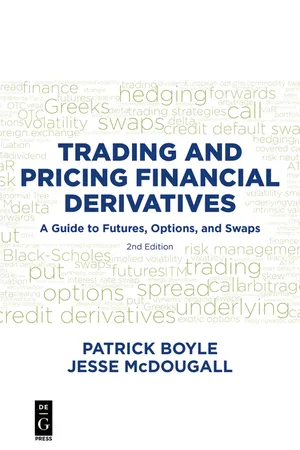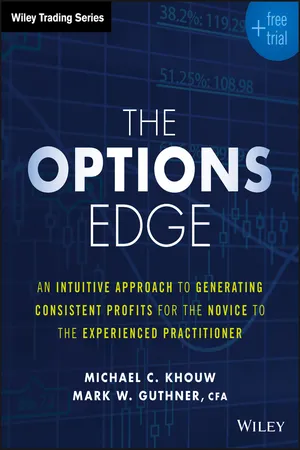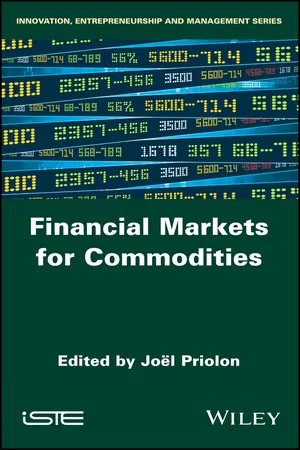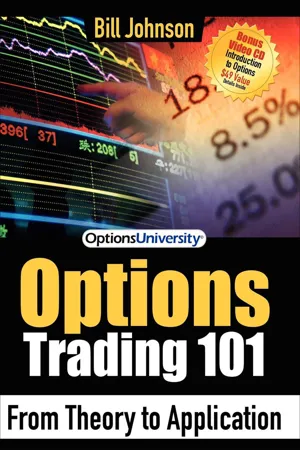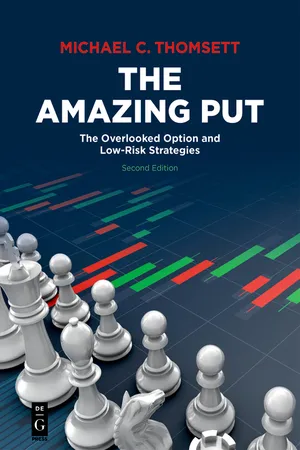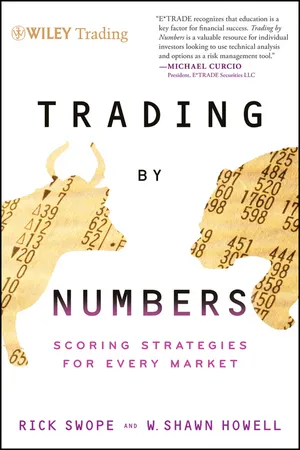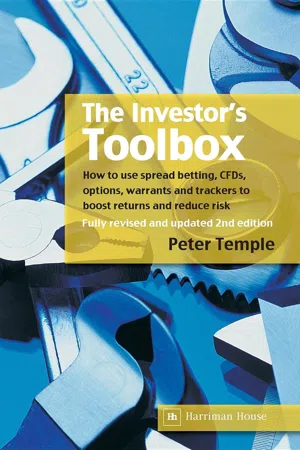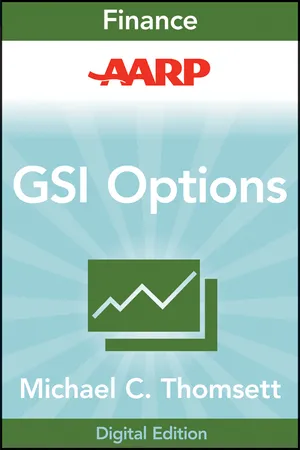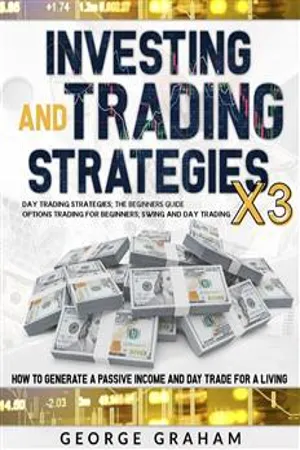Business
Put Options
Put options are financial contracts that give the holder the right, but not the obligation, to sell a specific amount of an underlying asset at a predetermined price within a set time frame. This allows investors to profit from a decline in the price of the underlying asset. Put options are commonly used as a hedging strategy to protect against potential losses in a declining market.
Written by Perlego with AI-assistance
Related key terms
Related key terms
1 of 4
Related key terms
1 of 3
11 Key excerpts on "Put Options"
- eBook - ePub
Trading and Pricing Financial Derivatives
A Guide to Futures, Options, and Swaps
- Patrick Boyle, Jesse McDougall(Authors)
- 2018(Publication Date)
- De|G Press(Publisher)
Chapter 3Introduction to Options
What Is an Option?
An option is a derivative financial instrument that specifies a contract between two parties for a future transaction on an asset at a reference price. The buyer of the option gains the right, but not the obligation, to engage in that transaction, while the seller incurs the corresponding obligation to fulfill the transaction. Options cost money to buy at inception while futures cost nothing to enter into, either as a buyer or as a seller, at inception.There are two basic types of option: calls and puts.Options Contract Specifications
Each financial option is a contract between two counterparties with the terms of the option specified in a term sheet. Some exotic options may have extremely complicated term sheets, but all contracts usually contain the following specifications:–A description of what the underlying asset is –Whether the option holder has the right to buy or the right to sell the underlying –The quantity and quality, or class, of the underlying asset –The “strike price,” which is the price at which the transaction will occur upon exercise –The expiration date, which is the last date the option can be exercised –Whether the writer must deliver the actual asset on exercise, or may simply tender the equivalent cash amountCall Option
The buyer of a call option has the right, but not the obligation, to buy agreed lots of 100 shares of the option by the expiration, for a certain price: the strike price. The seller (or “writer”) is obligated to sell the commodity or financial instrument should the buyer so decide.The buyer pays a fee, called a premium , for this right.Put Option
The buyer of a put option - eBook - ePub
The Options Edge
An Intuitive Approach to Generating Consistent Profits for the Novice to the Experienced Practitioner
- Michael C. Khouw, Mark W. Guthner(Authors)
- 2016(Publication Date)
- Wiley(Publisher)
expiration date. If the buyer of an option chooses not to exercise this right during the life of an option, it simply ceases to exist, and both parties go their merry way.There are two basic types of options, puts and calls. The type of option the investors select to use is dependent on their investment goals and risk management objectives. Since there are millions of investors employing different strategies trading options, both types are actively traded in the financial markets every day. A call option is a bullish instrument. It gives the buyer the right, but not the obligation, to purchase the underlying instrument at a predetermined price. Investors buy call options with the expectation that the price of the underlying security will rise. The seller of a call does so with the expectation that the price of the underlying instrument will stagnate or fall. Investors might buy a call to manage risk as well. Investors who hold a short position on the underlying instrument, with the expectation the price of that asset will fall, are at risk the price will spike higher. Buying a call allows short sellers to limit their risk by allowing them to buy back their short position at a predefined price. A put option is a bearish instrument. It gives the buyer the right, but not the obligation, to sell the underlying instrument at a predefined price. Investors buy Put Options with the expectation that the price of the underlying instrument will fall. Like calls, puts can be used for hedging as well. If you are long the underlying stock, you might purchase a put option to limit losses should the price of that stock fall.How Options Are Created, Extinguished, and Settled
Companies issue a fixed amount of stock, and those shares typically trade on an exchange. While options trade on exchanges much the same way stocks do, there is not a fixed amount of options outstanding. Options differ from stock in that they are created and destroyed as investors take positions during the normal course of trading. If Investor A wants to buy a call option on company XYZ, he instructs his broker to go to the exchange and find someone who wants to sell the same option. If he finds another investor or market maker, call her Investor B, who wants to sell that call with the same terms, and the two parties agree on a price, then a transaction takes place. Since Investor A does not own an option, he will “buy to open” a new position. If Investor B already owns the option she wants to sell, she will sell to close her current holding. In this process, an option is created and one is destroyed, and the total number of options outstanding does not change. If, on the other hand, there are no options outstanding or existing owners of the options do not want to sell, all is not lost. The broker finds a third party or market maker—call him Investor C, who wants to sell a call option he does not already own. Investor C writes a call option that does not currently exist and sells it to Investor A. Since Investor C does not own the option and is creating a new one, he sells to open - eBook - ePub
- Joel Priolon, Joel Priolon(Authors)
- 2018(Publication Date)
- Wiley-ISTE(Publisher)
5 Options MarketsOptions have seen considerable growth since the 1970s and, today, are among the most widely exchanged financial contracts on markets around the world. The basic principles on which options are based are easy to understand. However, the pricing of options is a difficult exercise based on an advanced mathematical corpus. This is why certain technical developments related to this are dicsussed in the Appendix.5.1. The fundamental conceptsAn option is a financial contract that binds the issuer, or writer of the option and the holder of the option, who has acquired the buying rights (option to buy) or the selling rights (option to sell) for certain goods, at a certain date (or over a certain period), at a price fixed in advance. In other words, the holder of an option has the right to buy or sell but has no obligation to exercise this right. When the contract is created, the option writer receives a premium paid by their acquirer. At the time when they commit to an options contract, the role of the seller and the buyer are unambiguous; but, going forward, the buyer may cede their option without, however, becoming the writer. This is why, in the rest of this chapter and in order to remove certain ambiguities, we will talk of “the writer” and not of the “seller”. Similarly, we will talk of the “holder of the option”, rather than “the buyer”. However, the reader must be aware that in other essays and books, these operators are very often called simply “seller” or “buyer”.
The vocabulary used when talking about options is quite particular. We have provided, below, a list of the most frequently used terms:5.1.1. Characteristics of options and a glossary- – call
- eBook - ePub
Options Trading 101
From Theory to Application
- Bill Johnson(Author)
- 2007(Publication Date)
- Morgan James Publishing(Publisher)
Chapter One
Introduction to Options
What Is an Option?
Options are simply legally binding agreements – contracts – between two people to buy and sell stock at a fixed price over a given time period.There are two types of options: calls and puts . A call option gives the owner the right, not the obligation, to buy stock at a specific price over a given period of time. In other words, it gives you the right to “call” the stock away from another person. A put option, on the other hand, gives the owner the right, not the obligation, to sell stock at a specific price through an expiration date. It gives you the right to “put” the stock back to the owner. Option buyers have rights to either buy stock (with a call) or sell stock (with a put). That means it is the owner’s choice, or option , to do so, and that’s where these assets get their name.Now you’re probably thinking that this is sounding complicated already. But options are used under different names every day by different industries. For instance, we are willing to bet that you’ve used something very similar to a call option before. Take a look at the following coupon:The way pizza coupons and call options work is very similar. This pizza coupon gives the holder the right to buy one pizza. It is not an obligation. If you are in possession of this coupon, you are not required to use it. It only represents a right to buy. There is also a fixed price of $10.00. No matter how high the price of pizzas may rise, your purchase price is locked at $10.00 if you should decide to use it. Last, there is a fixed time period, or expiration date , for which the coupon is good.Now let’s go back to our definition of a call option and recall that it represents:1) Right to buy stock2) At a fixed price 3) Over a given time period You can see the similarities between a call option and pizza coupon. If you understand how a simple pizza coupon works, you can understand how call options work. - eBook - ePub
The Amazing Put
The Overlooked Option and Low-Risk Strategies, Second Edition
- Michael C. Thomsett(Author)
- 2019(Publication Date)
- De Gruyter(Publisher)
2 Puts, the Other Options: The Overlooked Risk HedgeMost investors are optimists. They assume their stocks are going to rise in value, starting from the moment they invest. In fact, many people think of their basis price as the zero point of the investment, and prices are going to move upward from there. The reality—that the price you pay is part of a never-ending give and take between buyers and sellers—is that prices can move both up and down.For many, this presents a problem. What if the price does go down? Doesn’t that mean you lose money? No. With options, you can profit in any kind of market, whether stock prices rise or fall, and even when prices don’t move at all. Put-based strategies can limit losses, protect paper profits, and combine with other stock and option positions to create profits no matter what direction the market takes.With focus on strategies involving calls, the options market may easily ignore the potential for puts, both as speculative devices and for managing and hedging a long stock portfolio. When employed to hedge risk, puts enable you to maintain holdings even when markets are volatile to the downside. The alternative—selling off stock positions out of fear of further declines—leads to lost opportunities. The classic outcome—selling stock to avoid further losses only to miss the rebound—is probably the most common timing problem for investors. Puts can eliminate this market risk.The adage, “Buy low and sell high,” should contain a second part: “instead of the opposite.” The tendency is to buy into the market top in the belief that prices will continue rising indefinitely and sell into the bottom in fear or even panic that prices will continue their downward spiral. Puts are useful in both situations. Buying long puts at the market bottom can be done to take advantage of a rebound; it may also be done as a means for offsetting lost opportunities after selling stock. - eBook - ePub
Trading by Numbers
Scoring Strategies for Every Market
- Rick Swope, W. Shawn Howell(Authors)
- 2012(Publication Date)
- Wiley(Publisher)
CHAPTER 7 Long PutsFor most traders, call option strategies are more intuitive and more readily understood than put option strategies. We'll ease into the concepts by comparing the rights of a call buyer with the rights of a put buyer. Buying a call option involves the right to purchase shares at a specific price for a fixed amount of time. Unlike a call option, where the buyer has the right to purchase a stock, the put buyer has the right to sell a stock at a specified price for a fixed amount of time.GETTING TO KNOW THE STRATEGYFor investors with shares of a stock or exchange-traded fund (ETF) in their portfolio, puts can be used as a way to protect against downside risk in much the same way that insurance policies protect home and auto owners against property losses. Because put contracts share similarities with insurance policies, we will start to explain the concepts on that basis. Let's say a homeowner buys a vacation property on the coast of a low-lying island in the Gulf of Mexico for $300,000. He recognizes the potential for a hurricane to devastate the property, so he purchases insurance to protect the full value of the structure for $300,000. For this insurance he pays a premium of $3,000 for one year's worth of coverage with zero deductible.During the first year of ownership, no hurricanes hit the island and, therefore, there's no damage. His insurance policy expires unused and worthless. The homeowner renews the policy for a second year of coverage at a cost of $3,000 for $300,000 of coverage with a zero deductible. This year the homeowner is not so fortunate and a hurricane hits the island and destroys the house completely. The homeowner collects $300,000 under the terms of the policy. He has not profited $300,000, but rather he was reimbursed most of the cost to rebuild the structure. This is the essential purpose of insurance. - eBook - ePub
The Investor's Toolbox
How to use spread betting, CFDs, options, warrants and trackers to boost returns and reduce risk
- Peter Temple(Author)
- 2012(Publication Date)
- Harriman House(Publisher)
Let’s break this down into its component parts. First, “An option holder has the right, but not the obligation, to buy (or sell) . . .”In other words you have the right to choose to exercise your option if the terms look attractive. But because you have no obligation to use the option, you can choose to forfeit the small upfront premium you paid for it if exercising is not worth your while. Simply let the option lapse: end of story.But there is another element to this choice. You can also choose to sell your option in the market at a profit rather than undergo the process of exercising it. Or you can sell it some time before expiry even if you can’t exercise it at a profit. You may be able to recoup a part of the upfront cost of the option even if you have to sell it at a loss.One thing is certain: if the option can’t be exercised at a profit, when it expires it will have no value.Calls and Puts
The next question is why, in the definition I used above, did I use the phrase option to buy (or sell) ? The answer is simple. Options come in two flavours – call options and Put Options:- A call option is an option to buy at a fixed price for a known period of time.
- A put option is an option to sell at a fixed price for a known period of time.
Let’s say you have an option to buy - eBook - ePub
- Michael C. Thomsett(Author)
- 2011(Publication Date)
- Wiley(Publisher)
When you buy a put, it is as though you are saying, “I am willing to pay the asked price to buy a contractual right. That right provides that I may sell 100 shares of the specified stock at the indicated price per share, at any time between my option purchase date and the specified deadline.” If the stock’s price falls below that level, you will be able to sell 100 shares above current market value. For example, let’s say that you buy a put option providing you with the right to sell 100 shares at $80 per share. Before the deadline, the stock’s market value falls to $70 per share. As the owner of a put, you have the right to sell 100 shares at the fixed price of $80, which is $10 per share above the current market value. You own the right but you are not obligated. For example, if your put granted you the right to sell 100 shares at $70 but the stock’s market price rose to $85 per share, you would not be required to sell at the fixed price. You could sell at the higher market price, which would be more profitable. The potential advantage to option buyers is found in the contractual rights that they acquire. These rights are central to the nature of options, and each option bought or sold is referred to as a contract. The Call Option A call is the right to buy 100 shares of stock at a fixed price per share, at any time between the purchase of the call and the specified future deadline. This time is limited. As a call buyer, you acquire the right, and as a call seller, you grant the right of the option to someone else. (See Figure 1.1.) Let’s walk through an illustration and apply both buying and selling as they relate to the call option. • Buyer of a call : When you buy a call, you hope that the stock will rise in value, because that will result in a corresponding increase in value for the call - eBook - ePub
Investing and trading strategies X3
Day Trading Strategies, Options Trading for Beginners, Swing and Day Trading
- George Graham(Author)
- 2023(Publication Date)
- Youcanprint(Publisher)
CHAPTER 1:What is Options Trading?- What Are Options?
An option is a contract that gives the holder the right to sell or buy an asset at a set price (the strike price) within a given period (the term) but does not obligate the holder into doing so. The strike price may be lower or higher than the current asset price (market price).Like a bond or stock, an option is a tradable security. You can purchase or sell options to a foreign broker or trade them on an exchange within the United States. An option may give you the opportunity to leverage your cash, though it may be high risk because it eventually expires(expiration date). For stock options, each option contract represents 100 shares.- The Options Trading Concept
An instance of an option is if you want to buy a car/house, but for whatever reason, do not have immediate cash for it but will get the money next month. The item owner may agree to give you the option to purchase the house in a month for, let us say $250,000 if you pay $2,500 now for the option. Near the expiration of your option, the asset’s value may appreciate perhaps because of the discovery that the house is on a highly valued piece of land.You can now buy the asset at the agreed price and sell it for a profit. The asset's value may also depreciate perhaps when the house develops plumbing problems or other problems or, in the case of a vehicle, gets into an accident. If you decide not to buy the asset and let your purchase option expire, you lose your initial investment, the $2,500 you placed for the option.This is the general concept of how options trading happens; however, in reality, options trading is a lot more complex and involves more risks.- Basic Option Trading Terminologies
- eBook - ePub
An Introduction to International Capital Markets
Products, Strategies, Participants
- Andrew M. Chisholm(Author)
- 2009(Publication Date)
- Wiley(Publisher)
The combination is designed to provide downside risk protection - that is, to hedge against short-term falls in the price of the underlying asset. If the put is a physically exercised contract then it can be exercised when the price of the underlying falls below the strike. The underlying security is then sold at the strike price, eliminating any further losses. If the put is cash-settled then any losses incurred on the underlying below the strike price are compensated for through cash payments received from the writer of the contract. 19.2.1 Options versus Futures Hedge To illustrate the basic strategy this section takes the example of an investor who owns a stock currently trading at $ 100. The investor is concerned about the possibility of short-term falls in the value of the share due to general turbulence in the equity markets. The investor could of course sell the share and deposit the proceeds in the money markets, or switch into another financial asset. However this will incur transaction costs, and may also trigger tax liabilities. In addition, the investor may have built up the shareholding over time and may prefer not to switch simply because of short-term problems. And of course if the investor does make a premature switch there is the danger of incurring an opportunity loss - the loss of profits that would arise if the share price actually increased rather than fell. The investor could try to hedge the exposure by selling single stock futures or cash-settled equity forward contracts (see Chapter 15). Then if the share price falls the investor will be compensated in cash through gains on the derivative contracts. The disadvantage of this strategy is that the reverse would hold: profits on the stock would be offset by cash payments the investor would have to make on the futures or forward contracts. Figure 19.1 illustrates the net position resulting from a futures hedge - eBook - ePub
Quantum Trading
Using Principles of Modern Physics to Forecast the Financial Markets
- Fabio Oreste(Author)
- 2011(Publication Date)
- Wiley(Publisher)
Thus, if both vega and implied volatility fall sharply, then a short call position can be closed for a lower price than the selling price. Then the position can be closed with good profits.The main features of Call and Put Options can be found in Table 13.3 .Table 13.3 Call and Put OptionsCall Put Buyer (Long) Right to buy stocks at strike price Obligation to pay the premium Profit from an increase of underlying price Potential gains: Unlimited Potential losses: Limited Right to sell options at strike price Obligation to pay the premium Profit from a decrease in underlying price Potential gains: Unlimited Potential losses: Limited Seller (Short) Duty to sell stocks at strike price, if the option is exercised Right to cash in the option's premium Profits if the underlying price remains stable or decreases Potential gains: Limited to the premium Potential losses: Unlimited Duty to buy stocks at the strike price, if the option is exercised Right to cash in the option's premium Profits if the underlying price remains stable or increases Potential gains: Limited to the premium Potential losses: Unlimited
Index pages curate the most relevant extracts from our library of academic textbooks. They’ve been created using an in-house natural language model (NLM), each adding context and meaning to key research topics.
Explore more topic indexes
Explore more topic indexes
1 of 6
Explore more topic indexes
1 of 4
